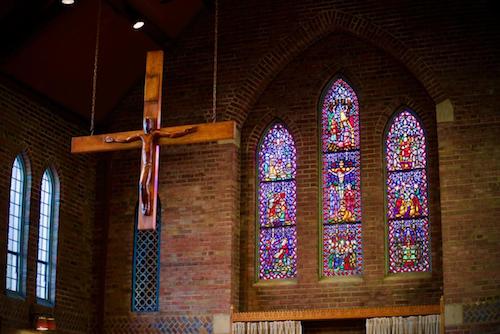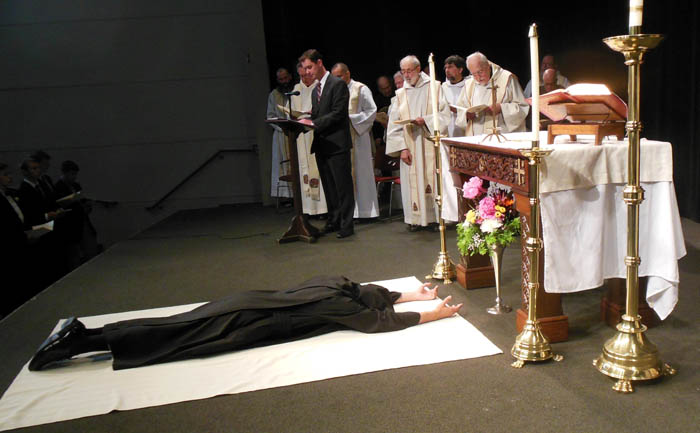What is Benedictine Life?
Just as the beauty of a stained glass window comes from the variety of its colors, each contributing in its own way to the radiance of the window as a whole, so too does the beauty of the Christian way of life arise from the many different ways in which persons can respond to Jesus’ words, “Come, follow me.” Within the Catholic Church, there is the calling not only to married life or to the diocesan priesthood but also to consecrated life in a wide variety of religious orders and congregations, of which the earliest form was monastic life. Monasticism first flourished in Egypt, Palestine, and Syria in the third and fourth centuries, and when it reached Italy, the movement was blessed with the holiness and wisdom of St. Benedict of Nursia, whose sixth-century monastic rule has ever since guided tens of thousands of men and women in a special way of following the Lord Jesus.
Here at St. Anselm’s Abbey, we try to live as faithfully as we can under St. Benedict’s Rule, even as we recognize that it is itself firmly based in the Gospel, which will always be the principal guide for any follower of Christ. Just as Jesus said that he came “not to be served but to serve” (Mark 10:45), so too did St. Benedict place much emphasis on the service that is to mark the life of every Benedictine monk. In fact, our holy founder called the monastery “a school for the Lord’s service,” and one of the most important aspects of life in this school is the prayer that we offer to God in our abbey church five times each day through the celebration of the Liturgy of the Hours and Eucharist. So central is prayer in our life that St. Benedict wants us always to be prayerful, so he writes in his short chapter on the oratory of the monastery that “if at other times someone wishes to pray privately, he may simply go in and pray, not in a loud voice, but with tears and heartfelt devotion.” We daily draw nourishment for such prayer through our reflective reading of the Bible and other spiritual literature.
While our prayer and holy reading are directed primarily to God, we give other kinds of service to our brother monks and to persons who are associated with the monastery in one way or another. For example, we regularly take turns serving at meals, something that is done not merely for practical reasons but as a way of “serving one another in love,” as St. Benedict writes near the beginning of his chapter on the weekly kitchen servers. The very next chapter, “On the Sick Brothers,” speaks of another kind of service: “Care of the sick must rank above and beyond all else, so that they may truly be served as Christ, for he said: ‘I was sick and you visited me,’ and, ‘What you did for one of these least brothers you did for me.’” All of this is beautifully summed up in the saint’s next-to-last chapter, where he writes that each monk is to “support with the greatest patience one another’s weaknesses of body or behavior” and to “pursue not what he judges better for himself but instead what he judges better for another,” so that by preferring nothing whatever to Christ, he “may bring us all together to everlasting life.”
Everyone who reads the Benedictine Rule is struck by its moderation, for St. Benedict offers a way of life that is open to anyone who truly seeks God and is willing to entrust his spiritual journey to the wise guidance of the Rule and of the abbot of a particular monastery. One of the finest expressions of the Benedictine spirit was once penned by a member of our own English Benedictine Congregation, Dom David Knowles, who wrote that one of the most intimate characteristics of Benedictine life is that “in the first place there is a kind of spiritual tolerance and ease, a spiritual elasticity and receptivity,” which means that “there should be in the Benedictine monk a certain restfulness, a contentment, not in doing nothing but in doing the familiar, even the monotonous and the ritual.” He “must be teachable and adaptable,” because for him “sanctity and the art of living on terms with many others are two aspects of the one task.”
While the overall framework of daily life is quite similar in Benedictine monasteries throughout the world, there are significant differences in the kinds of works they do. Our own abbey has long had as its major works those of education and hospitality. To carry out our educational work, we have an excellent abbey school for boys from grades six through twelve and at times have also had members of our community teaching in nearby universities and seminaries. For hospitality, we offer persons the opportunity of spending a few days with us on private retreat, and we also welcome groups who wish to use some of our rooms for their own workshops or days of recollection. Some of our monks also contribute to pastoral ministry in local parishes, especially on weekends, as well as serving as chaplains to communities of religious sisters. Still others have an active apostolate of giving spiritual direction or conducting retreats for laypersons and for other religious communities.
We cordially invite men who feel they may be called to our way of life to contact our vocations director at vocations@stanselms.org, and look into the possibility of visiting our abbey, for words like those in this short article can give only a general idea of what our life is like. Beyond that, we urge you to “come and see.”
– Abbot James A. Wiseman, O.S.B
Learn More About Vocations
If you are interested in visiting St. Anselm’s to learn more about vocations, we invite you to fill out our vocation visit application by clicking on the link below.
Interview with Abbot James Wiseman
Abbot James was interviewed by Guadalupe Radio about vocations. Listen to his 23 minute interview below.



